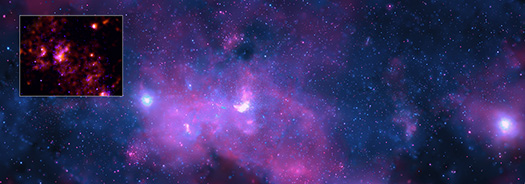Studies of Past X-ray Flares from Sgr A*
Submitted by chandra on Wed, 2023-06-21 13:35In a new Nature paper astronomers have reported exciting evidence that the supermassive black hole at the center of our Galaxy, Sagittarius A* (Sgr A* for short), produced an intense flare of X-rays about 200 years ago. Sgr A* is 28,000 light-years from Earth, but even from this considerable distance, if a similar flare occurred today then X-ray telescopes like IXPE and Chandra may be damaged if they looked at Sgr A*.
Currently Sgr A* shows frequent but weak outbursts, and has been referred to as a “sleeping giant” by members of the Event Horizon Telescope Collaboration.
In the new study astronomers learned about Sgr A*’s past outbursts by observing X-rays from clouds of gas around the supermassive black hole. While the primary X-rays from previous outbursts would have reached Earth in the past, X-rays reflected from clouds of gas will take a longer path and can arrive in time to be recorded by telescopes like Chandra and IXPE. This idea goes back decades, with the astronomers referring to a paper published in 1980. In the 1990s, several papers reported evidence for X-ray flares from the center of the Galaxy, including one in 1996 titled “ASCA View of Our Galactic Center: Remains of Past Activities in X-Rays?”.
Exploring Stephan's Quintet with Multiple Senses
Submitted by chandra on Tue, 2023-06-20 10:55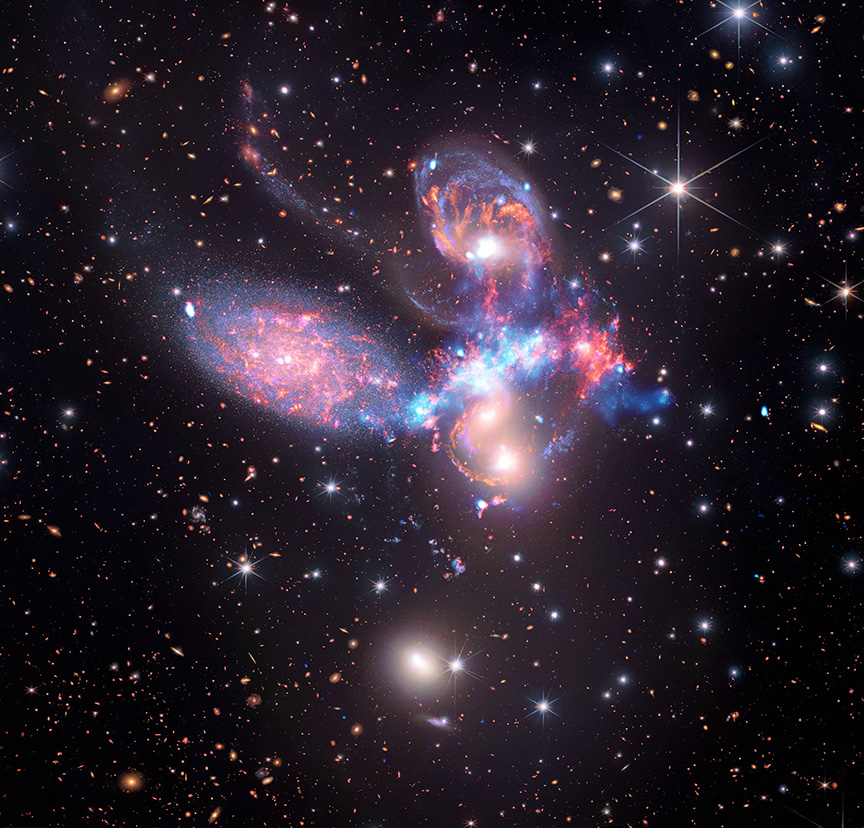
Stephan's Quintet
Credit: X-ray: NASA/CXC/SAO; IR (Spitzer): NASA/JPL-Caltech; IR (Webb): NASA/ESA/CSA/STScI
Summary
Experts created two new visual and auditory experiences to explore the complexity and beauty of a compact galaxy group known as Stephan’s Quintet. The guided three-dimensional visualization surveys the galaxies — their structures, characteristics, and interactions — captured in multiple wavelengths of light by some of NASA’s great observatories. The sonifications scan two-dimensional images of the quintet, translating the data into sound to reveal the depth and richness this intricate environment holds.
Using data gathered by NASA’s Hubble Space Telescope, Spitzer Space Telescope, Chandra X-ray Observatory, and James Webb Space Telescope, astronomers and visualization specialists from across several institutions came together to create two new unique sensory experiences of a compact group of galaxies known as Stephan’s Quintet: a video guiding viewers through a three-dimensional visualization of the galaxies, and audio tracks based on two-dimensional observation images. These add to the previously-developed multi-wavelength images, large tactile/audio display table, and small tactile images, bolstering the overall sensory experience of Stephan’s Quintet.
Milky Way's Central Black Hole Woke Up 200 Years Ago, NASA's IXPE Finds
Submitted by chandra on Fri, 2023-06-16 17:24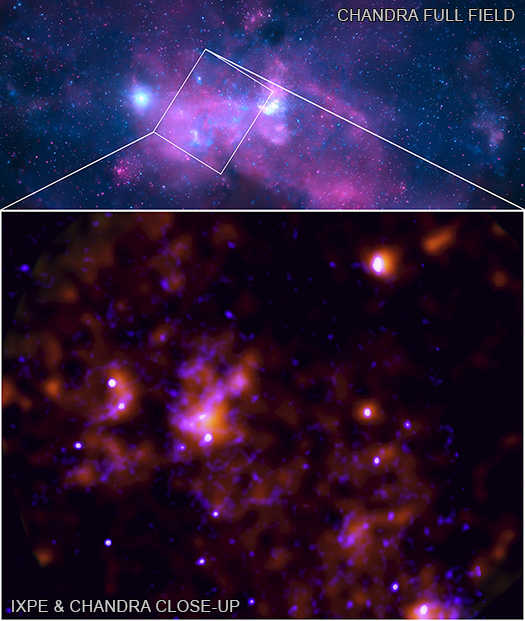
Sagittarius A* / Galactic Center
Credit: Chandra: NASA/CXC/SAO; IXPE: NASA/MSFC/F. Marin et al; Image Processing: L.Frattare, J.Major & K.Arcand; Sonification: NASA/CXC/SAO/K.Arcand, SYSTEM Sounds (M. Russo, A. Santaguida)
These images show X-ray data of the area around the supermassive black hole at the center of the Milky Way galaxy. New data from NASA’s Imaging X-ray Polarimetry Explorer (IXPE) has provided evidence that this black hole — known as Sagittarius A* (Sgr A*) — had an outburst about 200 years ago after devouring gas and dust within its reach.
Cosmic Harmonies: Sonifications From NASA Telescopes
Submitted by chandra on Thu, 2023-06-15 16:04Astronomers often look at objects in space through multiple telescopes. Because different telescopes can detect different types of light, each brings its own pieces of information to whatever is being observed. This is similar in some ways to how different notes of the musical scale can be played together to create harmonies that are impossible with single notes alone.
In the past few years, NASA has been producing “sonifications” of astronomical data of objects in space. This project takes the digital data captured by its telescopes in space — most of which is invisible to our unaided eyes — and translates them into musical notes and sounds so they can be heard rather than seen. Each layer of sound in these sonifications represents particular wavelengths of light detected by NASA’s Chandra X-ray Observatory, James Webb Space Telescope, Hubble Space Telescope, and Spitzer Space Telescope in various combinations.
Galaxies Go on a Deep Dive and Leave Fiery Tail Behind
Submitted by chandra on Tue, 2023-06-06 12:15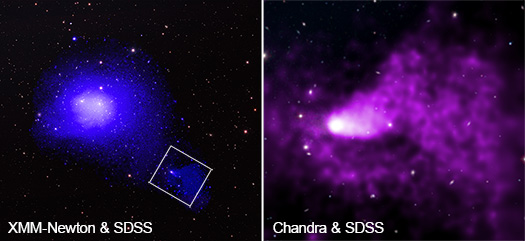
NGC 4839
Credit: X-ray: Chandra: NASA/SAO/Univ. of Alabama/M. S. Mirakhor et al.; XMM: ESA/XMM-Newton;
Optical: SDSS; Image processing: N. Wolk
A group of galaxies is plunging into the Coma galaxy cluster and leaving behind an enormous tail of superheated gas. Astronomers have confirmed this is the longest known tail behind a galaxy group and used it to gain a deeper understanding of how galaxy clusters – some of the largest structures in the universe – grow to their enormous sizes.
NASA's Chandra, Webb Combine for Arresting Views
Submitted by chandra on Tue, 2023-05-23 12:35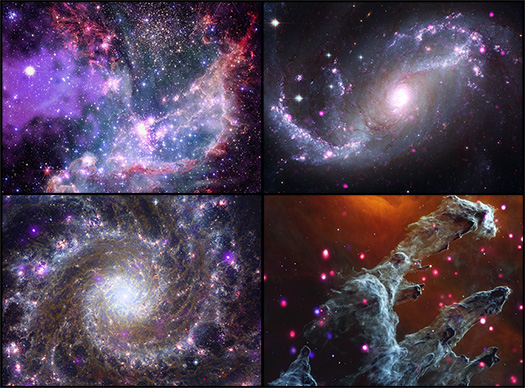
NGC 346, NGC 1672, M74 & M16
Credit: X-ray: Chandra: NASA/CXC/SAO, XMM: ESA/XMM-Newton; IR: JWST: NASA/ESA/CSA/STScI, Spitzer: NASA/JPL/CalTech; Optical: Hubble: NASA/ESA/STScI, ESO; Image Processing: L. Frattare, J. Major, N. Wolk, and K. Arcand
Four composite images deliver dazzling views from NASA's Chandra X-ray Observatory and James Webb Space Telescope of two galaxies, a nebula, and a star cluster. Each image combines Chandra's X-rays — a form of high-energy light — with infrared data from previously released Webb images, both of which are invisible to the unaided eye. Data from NASA's Hubble Space Telescope (optical light) and retired Spitzer Space Telescope (infrared), plus the European Space Agency's XMM-Newton (X-ray) and the European Southern Observatory's New Technology Telescope (optical) is also used. These cosmic wonders and details are made available by mapping the data to colors that humans can perceive.
'H' is for Hot and Huge in Chandra Image
Submitted by chandra on Wed, 2023-05-03 14:43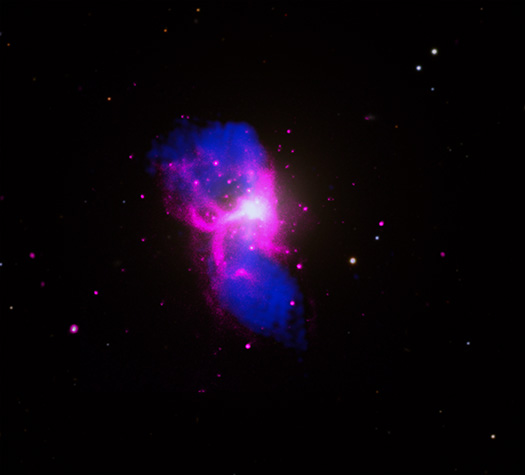
M84
Credit: X-ray: NASA/CXC/Princeton Univ/C. Bambic et al.; Optical: SDSS; Radio: NSF/NRAO/VLA/ESO; Image processing: NASA/CXC/SAO/N.Wolk
With a single letter seemingly etched in the X-ray glow around it, a giant black hole at the center of a massive elliptical galaxy is making a mark on its surroundings.
This “H”-shaped structure is found in a detailed new X-ray map of the multimillion-degree gas around the galaxy Messier 84 (M84).
As gas is captured by the gravitational force of the black hole, some of it will fall into the abyss, never to be seen again. Some of the gas, however, avoids this fate and instead gets blasted away from the black hole in the form of jets of particles. These jets can push out cavities, in the hot gas surrounding the black hole. Given the orientation of the jets to Earth and the profile of the hot gas, the cavities in M84 form what appears to resemble the letter “H.” The H-shaped structure in the gas is an example of pareidolia, which is when people see familiar shapes or patterns in random data. Pareidolia can occur in all kinds of data from clouds to rocks and astronomical images.
Centaurus A Shines in New Image from NASA's Chandra and IXPE
Submitted by chandra on Mon, 2023-05-01 11:46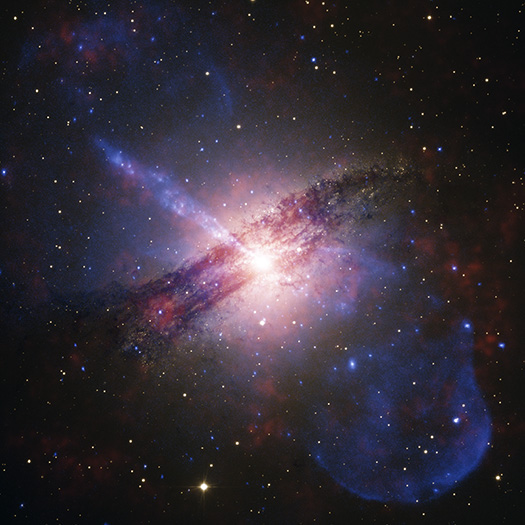
Centaurus A
Credit: X-ray: (IXPE): NASA/MSFC/IXPE/S. Ehlert et al.; (Chandra): NASA/CXC/SAO; Optical: ESO/WFI; Image processing: NASA/CXC/SAO/J.Schmidt
The galaxy Centaurus A (Cen A) shines bright in this image combining data from multiple observatories. In the center of this galaxy is a supermassive black hole feeding off the gas and dust encircling it, and large jets of high-energy particles and other material spewing out. The jet shown at the upper left of this image extends for about 13,000 light-years away from the black hole. Also visible is a dust lane, wrapping around the middle of the galaxy, which may have resulted from a collision with a smaller galaxy millions of years ago.
Colors in this image have been chosen to reflect the sources of data. Blue shows X-ray light captured by NASA’s Chandra X-ray Observatory, orange represents X-rays detected by NASA’s Imaging X-ray Polarimetry Explorer (IXPE) satellite, and optical light seen by the European Southern Observatory in Chile is colored white and gray.
Chandra’s Sight Sheds New Light: Gathering Insight on Earth, Life, and the X-ray Bright
Submitted by chandra on Wed, 2023-04-19 16:27We welcome Ian Brunton, a research scientist currently at NASA Johnson Space Center in the Astromaterials Research and Exploration Science Division as our guest blogger. In this post, he describes his team’s work below on the effects that a nearby supernova may have on an Earth-like planet and its biosphere. Ian first became involved with this area of research as an astronomy student of Brian Fields at the University of Illinois. He will soon be continuing his academic studies as a PhD student at Caltech in the Division of Geological and Planetary Sciences.
Much has been said about the extraordinary advancements throughout the field of astronomy, particularly regarding the innovative ways in which we can now observe the universe across the electromagnetic spectrum. Chandra has of course been one of the instruments at the forefront of this exploration for the last couple of decades, illuminating the universe in the X-ray band. These new ways of looking at our universe have served to confirm, alter, or entirely upend our prior notions of certain astrophysical processes.
What I personally find most intriguing is how these new observations can then be integrated into the knowledge and pursuits of other scientific disciplines, be it planetary science, atmospheric chemistry, geology, etc.
One of the most fascinating processes (if I may say so myself…) that orbital X-ray telescopes are especially handy for are supernovae, i.e., exploding stars! I’ll elaborate a bit on exactly why below, but first, some background on nearby supernovae and Earth is needed since our project really builds upon a lot of previous work in the field.
Everyone loves a good astronomical explosion, and supernovae — typically characterized by the wondrous spectacle of their initial outbursts — are some of the best explosions in the known universe. In the blink of an eye, these monstrous events can outshine the entire combined output of stars in a galaxy, launching neutrinos, photons, and stellar material out into the abyss of the interstellar medium.
A Pair of Merging Galaxies Ignite Black Holes on a Collision Course
Submitted by chandra on Wed, 2023-04-05 10:58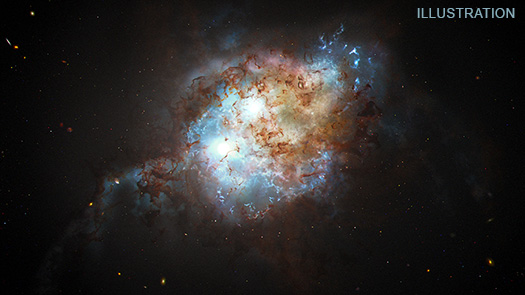
Artist's Illustration of Dual Quasar J0749+2255
Artwork Credit: NASA, ESA, Joseph Olmsted (STScI) Science Credit: NASA, ESA, Yu-Ching Chen (UIUC), Hsiang-Chih Hwang (IAS), Nadia Zakamska (JHU), Yue Shen (UIUC)
Quasars are among the universe's brightest fireworks. Scattered all across the sky, they blaze with the opulence of over 100 billion stars. And, like a brilliant July 4th aerial flare, they are dazzling for a relatively brief time — on cosmic timescales. That's because they're powered by voracious supermassive black holes gobbling up a lot of gas and dust that gets heated to high temperatures. But the quasar food buffet lasts only so long.
This fleeting characteristic of quasars helped astronomers find two quasars on a collision course with each other. They are embedded inside a pair of galaxies that smashed into each other 10 billion years ago. It's rare to find such a dynamic duo in the far universe. The detection yields clues as to how unsettled the cosmos was long ago, when galaxies more frequently collided and black holes were engorged with flotsam and jetsam from the close encounters.
Pages
Please note this is a moderated blog. No pornography, spam, profanity or discriminatory remarks are allowed. No personal attacks are allowed. Users should stay on topic to keep it relevant for the readers.
Read the privacy statement




